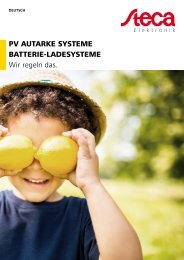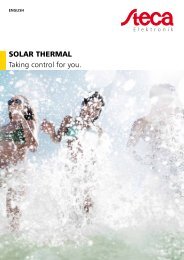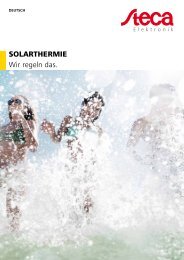Steca Elektronik catalogue PV Off Grid (13|2019)
You also want an ePaper? Increase the reach of your titles
YUMPU automatically turns print PDFs into web optimized ePapers that Google loves.
-<br />
+<br />
SOLAR-HOME-SYSTEMS<br />
with <strong>Steca</strong> solar charge controllers<br />
Overview of devices<br />
A solar home system consists of a <strong>Steca</strong> solar charge controller, one or more<br />
solar modules, a battery and the connected loads.<br />
The <strong>Steca</strong> solar charge controllers control the energy flow of the entire system.<br />
They make sure that the solar module charges the battery quickly and<br />
effectively, but they also protect the battery against overcharging. If the<br />
loads discharge the battery, the solar charge controller, thanks to its precision<br />
in calculating the state of charge, switches off the load at exactly the right<br />
moment, thus protecting the battery from the dangers of deep discharge.<br />
Furthermore, <strong>Steca</strong> solar charge controllers are equipped with an intelligent<br />
battery monitoring system. The most effective charging method is selected<br />
according to the requirements of the batteries. The solar charge controller is<br />
the central controlling component in solar home systems, for it affects all the<br />
functions of the system. For this reason, it is important to choose a reliable<br />
and high-performance solar charge controller.<br />
The solar charge controller is connected directly to the battery using a cable<br />
as short as possible, and fixed to the wall near to the battery, so that it can<br />
be effectively cooled by the passing air flow.<br />
In principle, the battery is always connected to the solar charge controller<br />
first. Then the solar module array is connected to the solar module input of<br />
the solar charge controller. Only direct current loads are used in solar home<br />
systems. They are connected directly to the load output of the solar charge<br />
controller. This means the <strong>Steca</strong> solar charge controllers always show the<br />
battery‘s exact state of charge, and thus ensure optimal battery maintenance<br />
in all situations. Various <strong>Steca</strong> energy-saving lights, <strong>Steca</strong> solar cooling units,<br />
DC-to-DC converters and other loads can be used.<br />
<strong>Steca</strong> Solsum<br />
Solar charge controller<br />
6 - 10 A; 12 / 24 V<br />
<strong>Steca</strong> PR<br />
Solar charge controller<br />
10 - 30 A; 12 / 24 V<br />
<strong>Steca</strong> Solarix PRS<br />
Solar charge controller<br />
10 - 30 A; 12 / 24 V<br />
<strong>Steca</strong> PR 2020 IP<br />
Solar charge controller<br />
20 A; 12 / 24 V<br />
<strong>Steca</strong> Solsum<br />
Solar charge controller<br />
25 - 40 A; 12 / 24 V<br />
<strong>Steca</strong> Solarix<br />
Solar charge controller<br />
25 - 40 A; 12 / 24 V<br />
<strong>Steca</strong> Solarix MPPT<br />
Maximum Power Point Tracker<br />
10 - 20 A; 12 / 24 V<br />
<strong>Steca</strong> Solarix MPPT<br />
Maximum Power Point Tracker<br />
30 - 50 A; 12 / 24 / 48 V<br />
Smartphone<br />
A<br />
B<br />
E<br />
C<br />
Key:<br />
A Solar modules<br />
B Solar charge controller<br />
C Battery<br />
E Load<br />
<strong>Steca</strong> PF 240-H<br />
Solar refrigerator/freezer<br />
240 l; 12 / 24 V<br />
<strong>Steca</strong> PF 166-H<br />
Solar refrigerator/freezer<br />
166 l; 12 / 24 V<br />
<strong>Steca</strong> LED<br />
LEDs<br />
4 W, 6 W, 8 W, 12 W<br />
12 / 24 V<br />
Australia<br />
Sweden Burkina Faso Botswana<br />
58 59

















